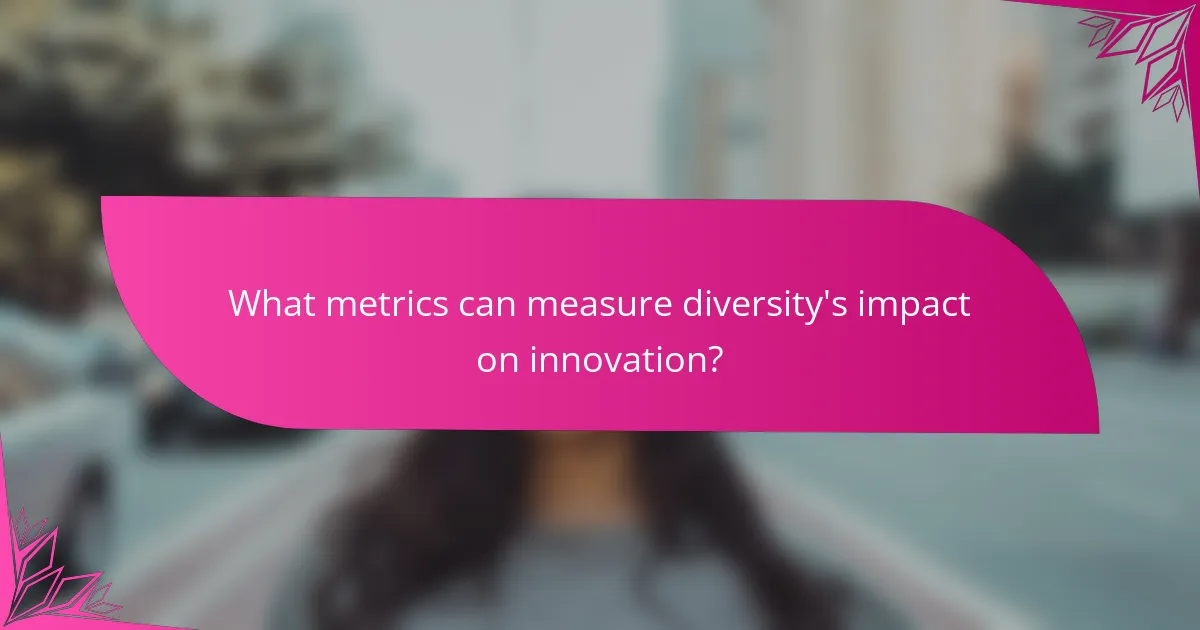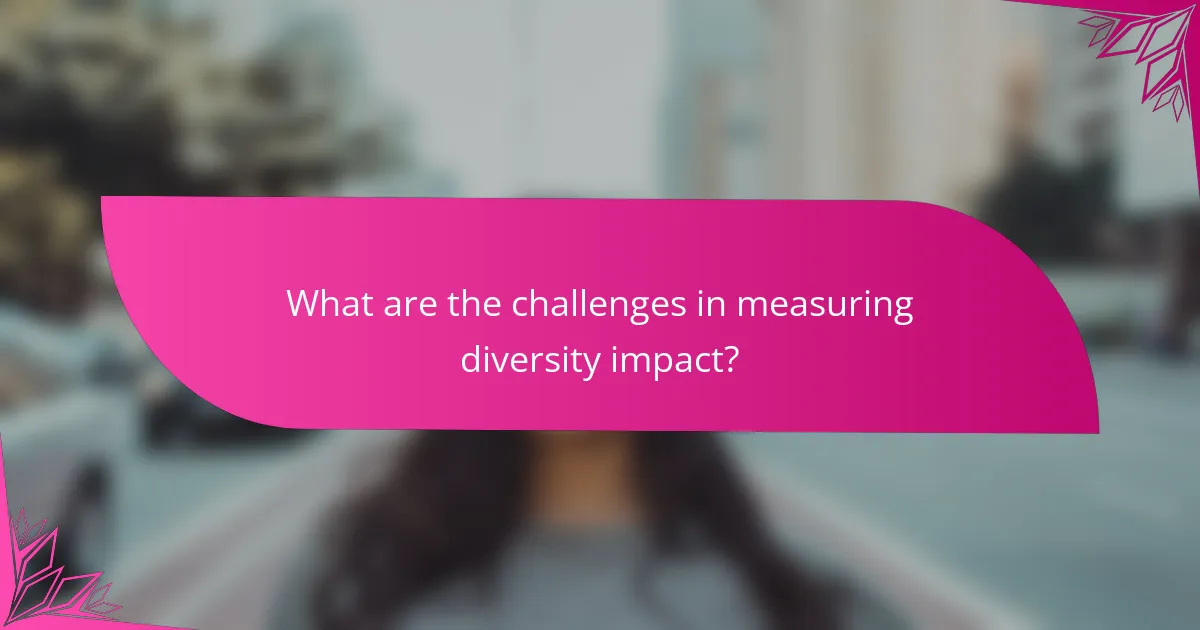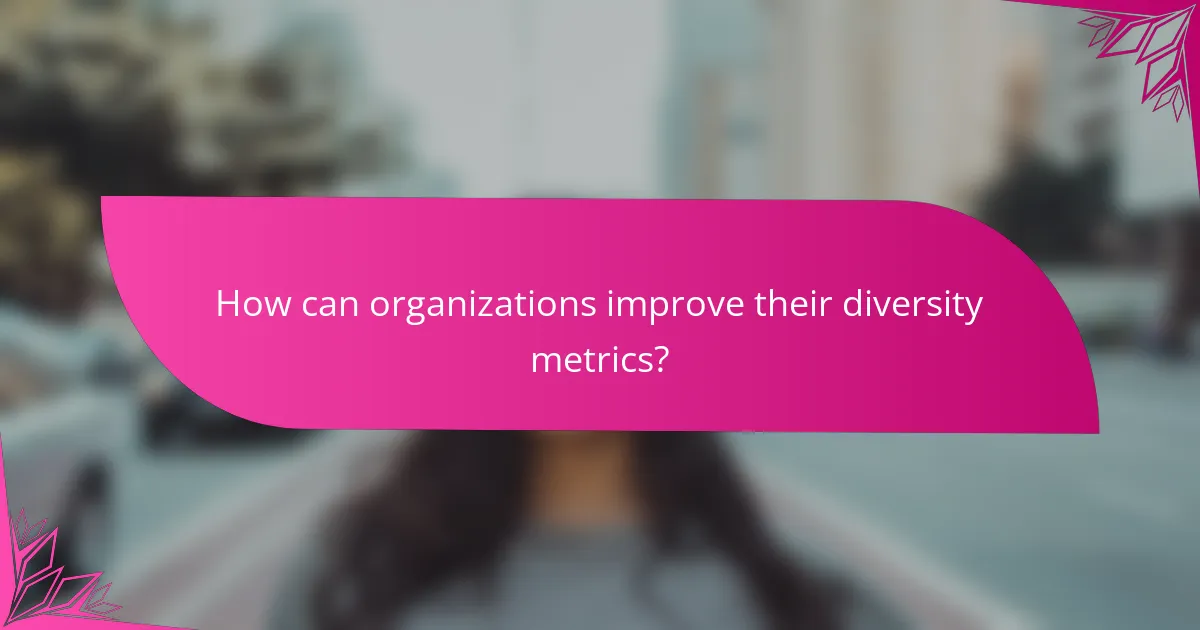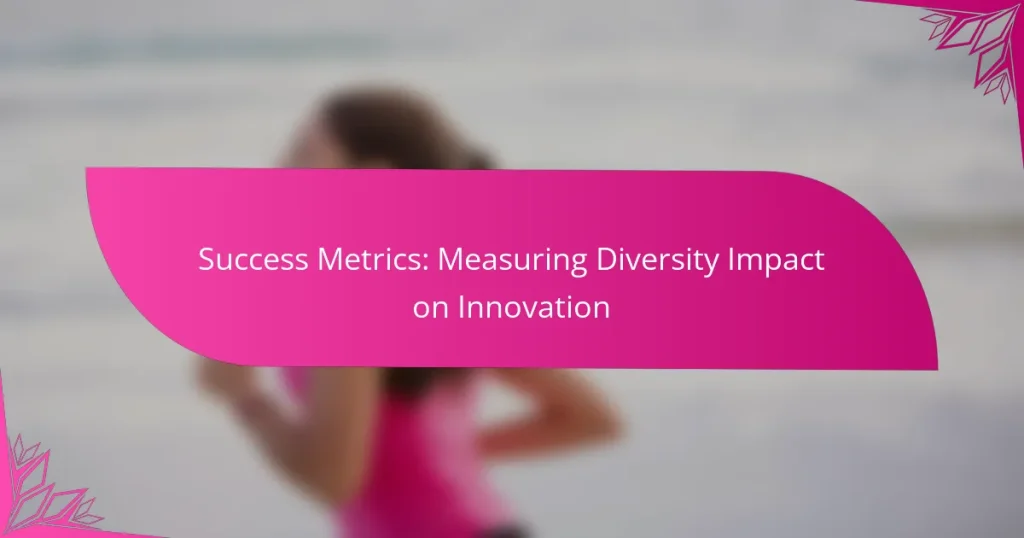Measuring the impact of diversity on innovation is essential for organizations seeking to leverage varied perspectives for enhanced creativity and problem-solving. By utilizing specific metrics such as employee engagement, retention rates, and the composition of diverse teams, businesses can assess how diversity contributes to their overall performance and adaptability. Implementing these metrics allows organizations to track progress and align their diversity objectives with innovation outcomes.

How does diversity impact innovation in organizations?
Diversity significantly enhances innovation in organizations by bringing together varied perspectives and experiences. This blend fosters creativity and leads to more effective problem-solving, ultimately driving business growth and adaptability.
Increased creativity and problem-solving
Diverse teams are more likely to generate unique ideas and solutions due to their varied backgrounds. This diversity of thought encourages brainstorming sessions that produce a wider array of innovative concepts.
Organizations can enhance creativity by actively promoting an inclusive culture where all voices are heard. For instance, implementing regular workshops that focus on collaborative problem-solving can leverage the strengths of diverse team members.
Enhanced market reach and customer insights
A diverse workforce can better understand and cater to a broader customer base, leading to improved market reach. Employees from different backgrounds can provide insights into the preferences and needs of various demographic groups.
To capitalize on this, organizations should consider forming cross-functional teams that reflect their target markets. This approach can help in developing products and services that resonate with diverse consumer segments, ultimately increasing sales and customer satisfaction.

What metrics can measure diversity’s impact on innovation?
Metrics that measure diversity’s impact on innovation include employee engagement and retention rates, as well as the number of diverse teams and projects. These indicators help organizations assess how diversity contributes to creative problem-solving and overall business performance.
Employee engagement and retention rates
Employee engagement and retention rates are critical metrics for understanding how diversity influences innovation. High engagement levels often correlate with diverse teams, as varied perspectives foster a more inclusive environment where employees feel valued and motivated. Retention rates can indicate whether diverse employees are satisfied and committed to the organization.
To effectively measure these rates, organizations should conduct regular employee surveys and analyze turnover data. Aim for engagement scores above 70% and retention rates of at least 80% for diverse employees to ensure a thriving, innovative workforce.
Number of diverse teams and projects
The number of diverse teams and projects is a straightforward metric that reflects an organization’s commitment to diversity and its potential impact on innovation. Tracking the composition of teams across various projects can reveal how diversity is integrated into the company’s structure and processes. A higher number of diverse teams often leads to a broader range of ideas and solutions.
Organizations should aim to have at least 30% of teams composed of individuals from varied backgrounds. Regularly review project outcomes to assess the effectiveness of diverse teams in driving innovation and consider implementing initiatives that promote the formation of such teams.

How to implement effective diversity metrics?
Implementing effective diversity metrics involves defining specific objectives and measuring progress against them. This process helps organizations understand how diversity impacts innovation and overall performance.
Establish clear goals and benchmarks
Setting clear goals and benchmarks is crucial for measuring diversity’s impact on innovation. Organizations should identify specific diversity targets, such as increasing representation of underrepresented groups in leadership roles by a certain percentage within a defined timeframe.
Benchmarks can include internal assessments, industry standards, or best practices from leading companies. Regularly reviewing these goals allows organizations to adjust strategies as needed and ensure accountability.
Utilize data analytics tools like Tableau
Data analytics tools like Tableau enable organizations to visualize and analyze diversity metrics effectively. By leveraging these tools, companies can track demographic data, employee engagement scores, and innovation outcomes, making it easier to identify trends and areas for improvement.
For example, a company might use Tableau to compare innovation outputs before and after implementing diversity initiatives. This analysis can reveal correlations between diverse teams and increased creativity or problem-solving capabilities, providing actionable insights for future strategies.

What frameworks support diversity measurement?
Several frameworks exist to measure diversity and its impact on innovation, helping organizations assess their inclusivity efforts. These frameworks provide structured approaches to evaluate diversity metrics, identify gaps, and implement strategies for improvement.
Diversity and Inclusion Index
The Diversity and Inclusion Index is a tool that quantifies an organization’s diversity efforts through various metrics, including representation, employee engagement, and retention rates. It typically assigns a score based on these factors, allowing companies to benchmark against industry standards.
To effectively use the index, organizations should regularly collect and analyze data on workforce demographics and employee feedback. This ongoing assessment helps identify areas for improvement and track progress over time.
Common pitfalls include relying solely on quantitative data without considering qualitative insights from employee experiences. A balanced approach that incorporates both types of data is essential for a comprehensive understanding of diversity and inclusion.
Global Diversity Benchmark
The Global Diversity Benchmark provides a framework for organizations to evaluate their diversity practices on an international scale. It focuses on best practices across different regions and industries, offering a comparative analysis that highlights effective strategies.
Organizations can utilize this benchmark by assessing their policies, recruitment processes, and workplace culture against global standards. This can help identify successful initiatives and areas needing enhancement, fostering a more inclusive environment.
When implementing the Global Diversity Benchmark, companies should consider local cultural contexts and legal regulations, as these factors can significantly influence diversity outcomes. Tailoring strategies to fit specific regional needs is crucial for achieving meaningful results.

What are the challenges in measuring diversity impact?
Measuring the impact of diversity on innovation presents several challenges, including data collection issues and resistance to change within organizations. These obstacles can hinder the ability to accurately assess how diversity contributes to innovative outcomes.
Data collection and privacy concerns
Collecting data on diversity often raises privacy issues, as individuals may be hesitant to share personal information related to race, gender, or other identity factors. Organizations must balance the need for comprehensive data with the ethical obligation to protect employee privacy. Implementing anonymous surveys and ensuring data security can help mitigate these concerns.
Additionally, the quality of data collected can vary significantly. Organizations should strive to use standardized metrics and benchmarks to ensure consistency. For example, using established frameworks like the Global Diversity and Inclusion Benchmarks can provide a reliable basis for comparison.
Resistance to change within organizations
Resistance to change is a common challenge when implementing diversity initiatives. Employees and leadership may be skeptical about the benefits of diversity, viewing it as a compliance issue rather than a strategic advantage. To overcome this resistance, organizations should communicate the tangible benefits of diversity, such as improved creativity and problem-solving capabilities.
Training programs that emphasize the value of diverse perspectives can also help shift mindsets. Engaging leadership in diversity efforts and showcasing success stories can further encourage buy-in from all levels of the organization.

How can organizations improve their diversity metrics?
Organizations can enhance their diversity metrics by implementing structured initiatives that focus on training, community engagement, and continuous assessment. These efforts should aim to create an inclusive environment that fosters innovation and reflects the diverse perspectives of their workforce.
Regular training and awareness programs
Regular training and awareness programs are essential for educating employees about diversity and inclusion. These programs should cover topics such as unconscious bias, cultural competence, and the benefits of diverse teams. Aim for quarterly sessions to keep the conversation ongoing and relevant.
Incorporating interactive elements like workshops or role-playing can enhance engagement and retention of information. Organizations can also consider using online platforms for flexibility, allowing employees to participate at their convenience.
Engagement with diverse communities
Engaging with diverse communities helps organizations understand different perspectives and needs. This can be achieved through partnerships with local organizations, sponsorship of community events, or participation in diversity-focused job fairs. Such initiatives not only improve outreach but also enhance the organization’s reputation.
It’s beneficial to create feedback loops with these communities to ensure that their voices are heard and considered in decision-making processes. Regularly assessing the impact of these engagements can help refine strategies and improve overall diversity metrics.

What are emerging trends in diversity measurement?
Emerging trends in diversity measurement focus on integrating qualitative and quantitative metrics to assess the impact of diversity on innovation. Organizations are increasingly using advanced analytics and employee feedback to create a more comprehensive understanding of diversity’s role in driving creative solutions.
Data-Driven Approaches
Data-driven approaches involve leveraging analytics to track diversity metrics across various dimensions, such as gender, ethnicity, and age. Companies are utilizing tools that analyze hiring patterns, promotion rates, and employee retention to identify gaps and opportunities for improvement. This method allows organizations to make informed decisions based on real-time data.
For instance, a tech company might analyze its workforce demographics and discover that women are underrepresented in leadership roles. By implementing targeted recruitment and mentorship programs, they can work towards a more balanced representation.
Employee Engagement Surveys
Employee engagement surveys are becoming a crucial tool for measuring the effectiveness of diversity initiatives. These surveys can provide insights into how employees perceive inclusivity within the organization and identify areas needing attention. Regularly conducting these surveys helps organizations gauge the impact of their diversity efforts over time.
For example, a retail company might find through surveys that employees from diverse backgrounds feel less valued. Addressing these concerns can lead to improved morale and productivity, ultimately enhancing innovation.
Benchmarking Against Industry Standards
Benchmarking against industry standards allows organizations to compare their diversity metrics with those of similar companies. This practice helps identify best practices and areas for growth. Many industries have established benchmarks, which can serve as a guideline for setting diversity goals.
For instance, a financial institution may compare its diversity statistics with those of leading firms in the sector to evaluate its performance. This comparison can motivate the organization to adopt successful strategies that enhance diversity and innovation.


